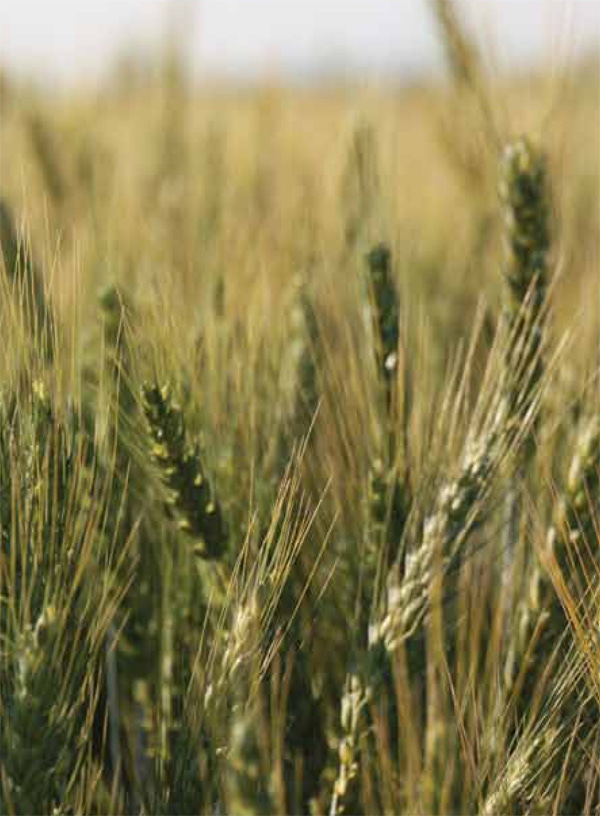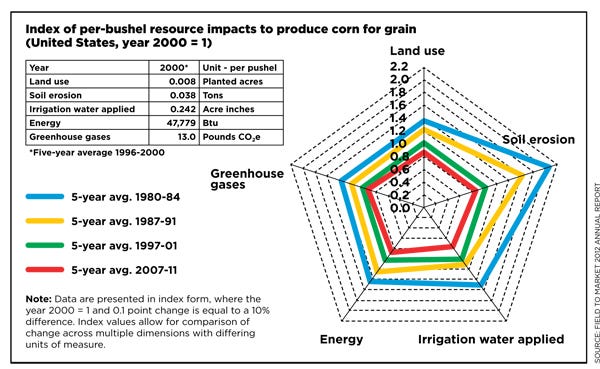December 10, 2013

2020 is not really that far off.
But in six years, food giant General Mills is committing to sustainably sourcing 100% of its 10 priority ingredients, two of which are corn and wheat. General Mills is among a growing list of food manufacturers, retailers, agribusinesses, grower organizations, conservation groups and others focusing on sustainable food, fiber and fuel production.
Why? A food company like General Mills essentially takes the output of Mother Nature, transforms this output into a food product, and sells it. If the front end breaks down, food companies, and essentially, the entire food supply chain, will feel the pain — not to mention anyone who eats.
Add to this climate change and the charge of feeding a global population projected to reach 8 billion by 2025 with limited natural resources, and sustainable agriculture quickly takes on greater significance.
Like what you’re reading? Subscribe to Farm Industry News Now e-newsletter to get the latest news and more straight to your inbox twice weekly.
General Mills and more than 50 other organizations are members of Field to Market: The Alliance for Sustainable Agriculture (fieldtomarket.org), whose Fieldprint projects involve partnering with growers to establish sustainability baselines for the fields they farm. Once baselines or benchmarks are established for a given area and production practices, growers can better understand where they can improve resource management — to produce crops more sustainably and economically, while improving and protecting the environment.
Calculating footprints
Determining a product’s “footprint” is very important to General Mills, says Jerry Lynch, the company’s chief sustainability officer, adding, “About two-thirds of our carbon footprint and 99% of our water footprint are in the raw materials we source.”
Field to Market has developed the Fieldprint Calculator (fieldtomarket.org/fieldprint-calculator) for corn, soybean, wheat, cotton, rice, potato and, in the near future, alfalfa growers. This calculator estimates field performance on the following sustainability indicators: land use, conservation, soil loss, irrigation water applied, water quality, energy use (number of equipment passes over a field, for example) and greenhouse gas emissions.
The grower enters his or her management data into the calculator, and these data (which remain confidential) are analyzed and transformed into a Fieldprint. Developed with the assistance of the USDA’s Natural Resources Conservation Service, the Fieldprint helps growers see how efficiencies and environmental impacts fluctuate based on their management decisions. It takes into account their respective production practices since a one-size-fits-all approach does not work. It also allows growers to compare with others on local, state and national levels, based on publically available data.
Between 350 and 400 growers in eight states are involved in 13 pilot projects, says Fred Luckey, chairman, Field to Market: The Alliance for Sustainable Agriculture. Between 134,000 and 140,000 acres are currently being “Fieldprinted.”
These pilot projects are supported by Field to Market member-organizations and growers. Bunge and Kellogg Co., for example, have been working the past five years with corn growers in Nebraska to produce the corn used in Kellogg’s Frosted Flakes more sustainably.
During the last two years, General Mills has been working with 25 wheat growers in Idaho’s Snake River Valley. These growers produce potatoes, sugarbeets and barley in rotation with wheat, which is also helping to provide useful information on the impacts of crop rotation on natural resources.

The “spider web” of information for a farm shrinks as the producer works in a more sustainable way. This Fieldprint for a farm can offer a producer a road map for improvement.
Lynch notes that the Idaho growers have made improvements in water stewardship through the use of variable-rate irrigation technologies. “These growers recognize water as their asset base.”
This can also help them reduce energy costs associated with running irrigation pumps and other equipment.
“We intend to continue working with growers who use the Fieldprint Calculator and expand the program to other regions,” Lynch says, adding that participating growers see the economic benefits of environmental efficiency. “We’re confident that more growers, who are managing pennies to the bushel, are going to be interested.” He encourages them to visit the Field to Market website.
Sustainably sourcing 100% of 10 priority commodities by 2020 is a tall order. Lynch says, “We understand that a lot of work has to be done yet. But we’ll understand more as we get more geographies under our belt. We’re committed to reaching our goals.”
This optimism is fueled by the contributions of crop input companies, grower organizations, processors, retailers, environmental groups and the public sector to the Field to Market program.
Collaboration is important, agrees Jennifer Shaw, head, Sustainable Sourcing Solutions, Syngenta North America. Because Field to Market participants use similar metrics, information can be aggregated to represent a geography from which a commodity is being sourced, she explains.
Syngenta has been working with several of its AgriEdge Excelsior growers in the Field to Market program. In 2010, it established a pilot project with a group of growers in the South who were producing corn, soybeans, wheat and cotton.
Growers accessed Field to Market metrics within their farm software, resulting in considerable time-savings, Shaw says. “From what we learned on that project, we then partnered with General Mills and the group of growers in Idaho.”
This project is still in its early stages, and the companies are collecting grower feedback. “Growers appreciate that we’re not telling them how to farm,” Shaw says, adding that the partners are focused on low-cost, pragmatic approaches to sustainably producing commodity crops. They want to avoid incurring extra costs and complexity. “The value must exceed the cost of doing this,” she says.
Tillage decision
Gary Edwards, a corn and soybean grower near Anamosa, Iowa, has been involved in the Field to Market program for about six years. He has served as the National Corn Growers Association representative to Field to Market. Having used the Fieldprint Calculator for a few years now, he says he has a better understanding of the effect of tillage on soil erosion, carbon sequestration and greenhouse gases. He has switched from conventional tillage to no-till.
Edwards also has feeder cattle and has used Fieldprint analyses to apply manure where it gives the most fertilizer value.
“The first time you enter information in the calculator, it takes a bit of work. But after the first time, it’s not that difficult,” Edwards says, explaining that he put in two or three years’ worth of data at the outset. This included information such as soil-test data, amounts of crop inputs applied, type of application equipment used, number of trips across the field and yield data.
The Iowa grower believes that in the future, farmers will be asked how sustainable their production practices are. “If I’m asked that question, I’ll have an answer,” Edwards says.
Sustainability will become an increasingly important issue as more retailers establish sustainable sourcing models and require suppliers along the food supply chain to follow suit. In fact, Walmart and McDonald’s Corp. are members of Field to Market.
U.S. growers already have a good sustainability story to tell, says the alliance’s Luckey, pointing to the Field to Market 2012 Environmental and Socioeconomic Indicators Report (fieldtomarket.org/report), which analyzed crop production trends between 1980 and 2011. This study shows that growers of corn, cotton, potatoes, rice, soybeans and wheat have improved resource use/impact per unit of production for all of the environmental indicators.
But farmers will be facing population growth, climate change and natural resource challenges. Field to Market partners and growers understand this. And through the magnifying glass of Fieldprint projects, they have a clear vision of sustainable agriculture for making improvements moving forward.
About the Author(s)
You May Also Like




